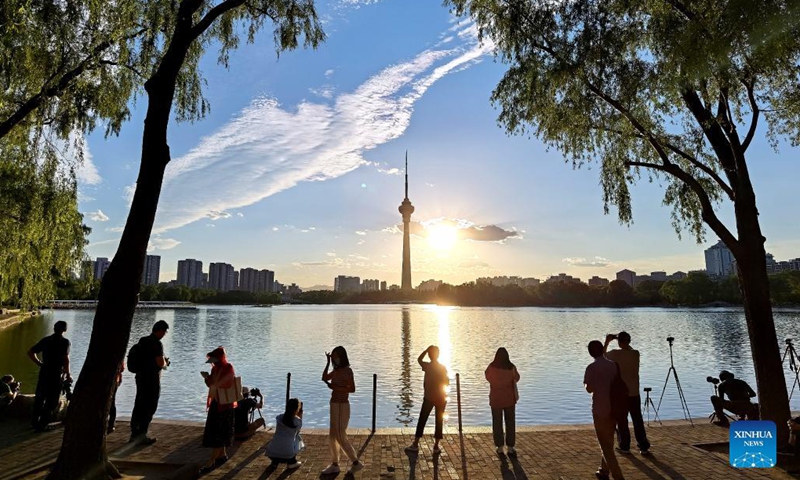
Photo taken with a mobile phone shows people watching sunset in Yuyuantan Park in Beijing, capital of China, June. 17, 2021. Photo:Xinhua
The average concentration of PM2.5 in Beijing is expected to be about 35 micrograms per cubic meter by 2025, which means the city plans to basically eliminate heavily polluted days, municipal ecology and environment authorities said on Wednesday. The capital city is expecting "Beijing Blue" to become the norm.
In 2020, the average concentration of PM2.5 in Beijing entered the level of 30-plus micrograms per cubic meter for the first time. From 2016 to 2020, the rate of decline exceeded 50 percent, Liu Xianshu, a deputy director of the Beijing Municipal Ecology and Environment Bureau, said at a press briefing on ecological and environmental protection planning during the 14th Five-Year Plan (2021-25) period.
Eight districts in Beijing have met the level-II national standard for PM2.5 control, the city's surface water quality has continued to improve, and the soil is in good condition, according to Liu. The level-II national standard for PM2.5 control is 35 micrograms per cubic meter.
China has made great efforts in various fields to reduce pollution and improve overall air quality, and it aims to hit peak carbon emissions before 2030 and achieve carbon neutrality before 2060.
The proportion of days with good air quality in cities at the prefectural level and above across China reached 87 percent in 2020, increasing 5.8 percentage points compared with 2015, according to national environment authorities.
"Beijing has witnessed big changes in its development environment during recent years thanks to the city's scientific management of environmental pollution," Zhang Yuanxun, a professor of College of Resources and Environment, University of Chinese Academy of Sciences, told the Global Times on Wednesday. Zhang was quite optimistic that the city could reach the goals set in the plan.
On a national level, Zhang said that it's important for local authorities to stick to the environmental protection measures and seek a balance between environmental protection and economic development.
For the 2025 goals, the plan sets a total of 16 indicators across five dimensions: low-carbon development, cleaner air, cleaner water, safer soil, and a more livable ecology. The indicators include carbon emissions intensity, the annual PM2.5 average concentration, the ratio of good days, and the ratio of heavily polluted days.
By 2035, the plan envisions a fundamental improvement in the environment and a sufficient supply of quality ecological products, as well as recognition of a green lifestyle. There will be significant progress in carbon neutrality, Beijing will provide blue skies and clean water, and forests will be basically regenerated.

Photo taken with a mobile phone shows people watching sunset in Yuyuantan Park in Beijing, capital of China, June. 17, 2021. Photo:Xinhua
The average concentration of PM2.5 in Beijing is expected to be about 35 micrograms per cubic meter by 2025, which means the city plans to basically eliminate heavily polluted days, municipal ecology and environment authorities said on Wednesday. The capital city is expecting "Beijing Blue" to become the norm.
In 2020, the average concentration of PM2.5 in Beijing entered the level of 30-plus micrograms per cubic meter for the first time. From 2016 to 2020, the rate of decline exceeded 50 percent, Liu Xianshu, a deputy director of the Beijing Municipal Ecology and Environment Bureau, said at a press briefing on ecological and environmental protection planning during the 14th Five-Year Plan (2021-25) period.
Eight districts in Beijing have met the level-II national standard for PM2.5 control, the city's surface water quality has continued to improve, and the soil is in good condition, according to Liu. The level-II national standard for PM2.5 control is 35 micrograms per cubic meter.
China has made great efforts in various fields to reduce pollution and improve overall air quality, and it aims to hit peak carbon emissions before 2030 and achieve carbon neutrality before 2060.
The proportion of days with good air quality in cities at the prefectural level and above across China reached 87 percent in 2020, increasing 5.8 percentage points compared with 2015, according to national environment authorities.
"Beijing has witnessed big changes in its development environment during recent years thanks to the city's scientific management of environmental pollution," Zhang Yuanxun, a professor of College of Resources and Environment, University of Chinese Academy of Sciences, told the Global Times on Wednesday. Zhang was quite optimistic that the city could reach the goals set in the plan.
On a national level, Zhang said that it's important for local authorities to stick to the environmental protection measures and seek a balance between environmental protection and economic development.
For the 2025 goals, the plan sets a total of 16 indicators across five dimensions: low-carbon development, cleaner air, cleaner water, safer soil, and a more livable ecology. The indicators include carbon emissions intensity, the annual PM2.5 average concentration, the ratio of good days, and the ratio of heavily polluted days.
By 2035, the plan envisions a fundamental improvement in the environment and a sufficient supply of quality ecological products, as well as recognition of a green lifestyle. There will be significant progress in carbon neutrality, Beijing will provide blue skies and clean water, and forests will be basically regenerated.

